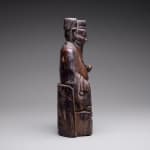Qing Sculpture of a Taoist Deity, 1644 CE - 1911 CE
Wood
28.6 x 13 cm
11 1/4 x 5 1/8 in
11 1/4 x 5 1/8 in
PF.5160
Further images
Seated in a wide stance with his right hand placed on top of his knee, this figure assumes a posture fitting for an emperor, deity, or noble ancestor. In his...
Seated in a wide stance with his right hand placed on top of his knee, this figure assumes a posture fitting for an emperor, deity, or noble ancestor. In his right hand, he carries and emblematic object shaped like a bowl. Despite this formalistic position, the figure conveys a sense of humor and generosity in his warm facial expression and bulging belly. Most likely, it is a representation of one of the many members of the Taoists pantheon, be it an immortal, a celestial being, or a deity. Taoism is an indigenous religion to China and flourished in conflict with the immigrant religion of Buddhism. However, acknowledged and unacknowledged appropriations of ideas, iconographies, and cultural and religious practice were numerous. Taoism concerns itself with the attainment of immortality--the highest form of personal salvation in which the deathless dwell in a variety of paradises. From that, a complex cosmology concerned with medicine, astrology, and physical cultivation emerged articulating its doctrine in canonical texts and through an entourage of divine beings based, in some cases, on factual historical personages. Perhaps this wooden statue depicts one of the legendary Eight Immortals or the God of Happiness in transit from the mountain paradises to the land of mortals bringing fortune and happiness to all those deserving.







